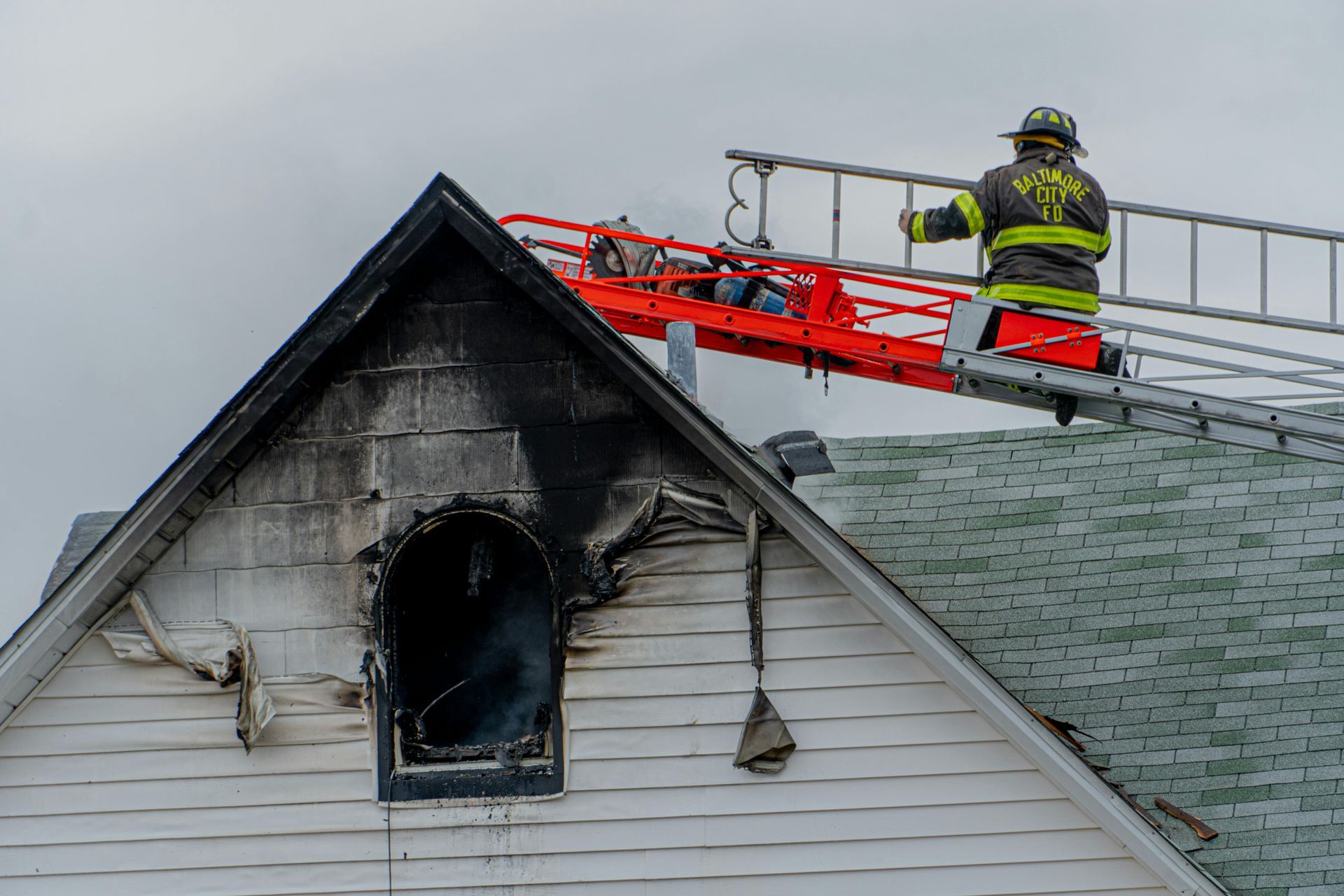Emergency Roofing Solutions: Your Step-by-Step Guide to Handling a Roof Leak Crisis
A roof leak can turn into a disaster in minutes. Whether it's a minor drip or a major downpour inside your home, fast action is key to minimizing water damage, mold growth, and costly repairs. At Diamond State Property Preservation, we know that roof leak emergencies can strike without warning—and we’re here to help you respond quickly and effectively.
In this guide, we’ll walk you through everything you need to know when dealing with a roof leak emergency, from identifying the problem to implementing emergency roofing solutions and knowing when to bring in the pros.

What Causes a Roof Leak Emergency?
A roof leak emergency often starts with something minor—an overlooked crack, a dislodged shingle, or a slow drip. But under the right conditions, that small issue can escalate into a full-blown crisis, especially during a storm or extreme weather event. Understanding the most common causes can help you prevent problems or respond more quickly when they happen.
Broken or Missing Shingles
Shingles act as the first line of defense against rain, wind, and sun. When shingles are torn off or cracked—usually due to age, wind, or hail—moisture can slip beneath them and seep into the underlying layers of your roof. Even a single missing shingle can create an access point for water, especially during heavy downpours.
Damaged Flashing Around Vents, Chimneys, or Skylights
Flashing is the thin metal material used to seal joints and prevent water from penetrating the seams where the roof meets vertical features like chimneys, skylights, and vent pipes. Over time, flashing can become corroded, lifted, or improperly sealed, creating hidden vulnerabilities. Once flashing fails, water can flow freely into your attic or ceiling cavities, often without immediate visible signs.
Clogged Gutters That Trap Water on the Roof
Gutters and downspouts are designed to direct rainwater away from your roof and foundation. When they become clogged with leaves, dirt, or debris, water can back up and pool on your roof instead. This ponding effect increases the risk of leaks, especially around the roof edge where shingles may already be weaker. Over time, standing water can erode materials and saturate the roof deck, leading to interior leaks.
Ice Dams Forming at the Edge of Your Roof
In colder climates, ice dams occur when heat from your attic causes snow on your roof to melt, only to refreeze at the eaves where it’s colder. This refrozen ice forms a barrier that prevents proper drainage, forcing water to back up under the shingles. The trapped moisture can eventually leak into your home, causing significant damage to ceilings, walls, insulation, and even electrical wiring.
Aging or Improperly Installed Roofing Materials
All roofing materials have a limited lifespan. As your roof ages, shingles can become brittle, adhesives lose strength, and underlayment materials may deteriorate. If your roof was installed without proper techniques or materials, it may develop problems much sooner. Gaps, misaligned shingles, and poor sealing are often invisible until a major weather event exposes them.
Improper installation also includes using incompatible materials or skipping essential layers like waterproof barriers or proper ventilation—mistakes that can shorten your roof’s life and increase the risk of leaks under pressure.
Punctures from Falling Branches or Debris
Storms often bring high winds, which can cause overhanging tree limbs or flying debris to crash onto your roof. The impact may puncture shingles, damage flashing, or even break through the decking underneath. These sudden breaches in your roofing system can allow water to enter your home immediately, especially during or right after the storm.
Why Fast Action Matters
No matter the cause, roof leaks are more than just an inconvenience. If ignored, even a small leak can lead to:
- Mold and mildew growth inside your attic or walls
- Rotted wood framing and roof sheathing, compromising structural integrity
- Damaged insulation, reducing energy efficiency
- Short-circuited electrical systems and fire risks
- Ceiling collapses or interior flooding, especially in multistory homes
That’s why any sign of a leak should be treated as an urgent matter—and why fast, professional emergency roofing solutions are essential to protect your property.
Step 1: Stay Calm and Assess the Situation
When water starts dripping from your ceiling, it's natural to panic—but staying calm is the first step toward damage control.
- Look for signs of active leaks: water stains, bulging drywall, or water pooling on floors.
- Identify the source if possible. Leaks may travel from the roof through the attic and appear far from their origin.
- Determine the severity. Is it a slow drip, or is water coming in rapidly?
If it’s safe, enter your attic or upper floor to inspect the area directly under the roof. Bring a flashlight and avoid stepping on wet insulation or ceiling materials.
Step 2: Contain the Water
Your next priority is preventing further damage to your belongings and flooring.
- Place a bucket or large container under the leak.
- Use towels or tarps to soak up or divert water away from furniture and electronics.
- If water is bulging from the ceiling, puncture it with a screwdriver to release the pressure. This can prevent the entire ceiling from collapsing.
Don’t forget to move valuables out of the affected area. The sooner you contain the leak, the less you’ll have to replace later.
Step 3: Perform Temporary Leak Control (If Safe)
If the weather permits and it’s safe to access your roof, you may apply temporary emergency roofing solutions while you wait for professional help.
Some options include:
- Roofing tape or caulk to patch small holes or cracked flashing
- Tarping the roof: Use a heavy-duty tarp, secured with nails or weighted objects, to cover the leak area and prevent additional water entry
- Plastic sheeting inside: For extensive damage, hang plastic from ceiling joists to channel water into containers
Avoid getting on your roof in poor weather. Slippery surfaces can lead to serious injury. In most cases, a temporary indoor fix is the safest choice until professional roof leak repair is possible.
Step 4: Document the Damage
Take photos and videos of:
- The visible leak
- Damage to ceilings, walls, and floors
- Any affected belongings (furniture, electronics, etc.)
- The condition of your roof if safely accessible
This documentation is crucial for homeowners’ insurance claims and will also help your roofing contractor assess the scope of damage when they arrive.
Step 5: Call for Emergency Roofing Solutions
Once the immediate threat is under control, contact a trusted contractor who specializes in emergency roofing solutions. Delaying this step can lead to:
- Worsening water intrusion
- Mold and mildew growth
- Permanent structural damage
At Diamond State Property Preservation, our roofing experts are trained to handle emergencies with speed and professionalism. We offer prompt service throughout Townsend, DE, and surrounding areas. Whether it’s a small patch or full roof repair, we’ll ensure your home is protected from further damage.
Step 6: Schedule a Full Roof Inspection
Even if the leak seems minor, don’t assume the problem is fully resolved until a comprehensive roof inspection is performed. Our licensed roofing team will:
- Identify the source of the leak
- Inspect all vulnerable areas (shingles, flashing, underlayment, attic, etc.)
- Evaluate whether water has compromised internal materials
- Recommend repair or replacement options, depending on the extent of the damage
Roof inspection services are your best defense against repeat leaks or hidden moisture damage.
Step 7: Repair or Replace Damaged Roofing Materials
Once the inspection is complete, your contractor will guide you through the next steps:
- Minor Repairs: Replacing shingles, sealing flashing, patching small punctures
- Major Repairs: Fixing structural decking, extensive flashing damage, or chimney caps
- Roof Replacement: If your roof is over 20 years old or has sustained multiple issues, a full replacement may be the most cost-effective option
At Diamond State Property Preservation, we prioritize long-term solutions. Our team will walk you through every option so you can make an informed decision that protects your home.
Step 8: Prevent Future Roof Leaks
After emergency roof repairs are complete, take proactive steps to prevent another crisis:
- Schedule routine roof inspections every 6 to 12 months
- Clean gutters and downspouts regularly
- Trim overhanging trees that can drop limbs or leaves onto your roof
- Install proper attic insulation and ventilation to reduce ice dam formation
- Monitor ceilings and attic spaces for early signs of leaks
We also offer seasonal roof maintenance packages designed to catch small problems before they become emergencies.
When to Call for Emergency Roofing Solutions
Don’t wait for a ceiling collapse to act. Reach out to emergency roofing professionals if:
- You notice water actively entering your home during or after a storm
- You see missing shingles, broken vents, or large debris on your roof
- There are visible water stains spreading quickly on ceilings or walls
- Your attic smells musty or feels unusually damp
- You’ve temporarily patched a leak but need a permanent repair
The faster you call, the less damage you'll have to undo.
Final Thoughts
A roof leak emergency is a stressful situation—but with the right steps and the help of trusted professionals, you can protect your home from further damage. Whether you’re dealing with a sudden leak during a storm or discovering water stains weeks later, fast action and expert guidance make all the difference.
Don’t let a small leak turn into a major disaster. At Diamond State Property Preservation, we specialize in fast, dependable emergency roofing solutions across Delaware and surrounding areas. Whether it’s storm damage, sudden leaks, or long-term wear, our skilled team is here to respond 24/7.
Contact us today to schedule your emergency roof leak repair or comprehensive roof inspection service—and restore peace of mind for your family and your home.


